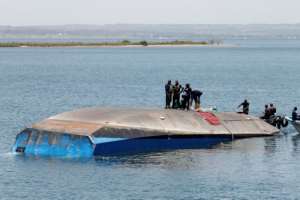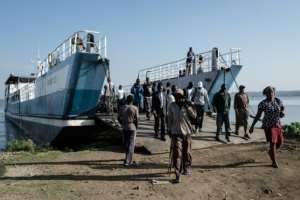
Time-worn and weather-beaten, the MV Mbita III tilts slightly to the left as it creaks out of its Kenyan port on Lake Victoria.
"There's no problem," smiles the ferry captain, Eric Charles, as he heads into the calm waters of Africa's largest lake, which lies within three countries, carrying only a few dozen passengers and vehicles.
But on the deck, not everyone is convinced, with the memory still fresh of the sinking of the MV Nyerere two weeks ago, just over 200 kilometres (124 miles) away in Tanzanian waters, leaving 228 dead.
The accident highlighted the risks for the thousands of residents on the shores and islands of the lake, forced to use overcrowded or poorly maintained boats to go about their business, in a region where few know how to swim.
"I'm not too worried about overloading of the ship, but the question is the maintenance of the ship," said fisherman Peter Ochyeng, 25, casting a skeptical gaze over the paint peeling off the vessel.
"Me, I pray to God that nothing happens like in Tanzania."
As he steers the boat across the bay from western Kenya to the town of Mbita -- a route that saves passengers an hours-long journey by road -- Charles insists that "Kenya is not Tanzania".
"This boat has a capacity of 400 passengers and I will never let more passengers in," he said.
Charles also said that more people died in accidents involving small wooden boats and canoes on Lake Victoria, than in large ferry accidents.
The MV Nyerere was carrying more than three times the amount of passengers recommended, and capsized just metres from its final destination, the island of Ukara -- but those who died were unable to swim to safety.
 Residents on the shores and islands of lake Victoria are forced to use overcrowded or poorly maintained boats to go about their business, in a region where few know how to swim. By Yasuyoshi CHIBA (AFP)
Residents on the shores and islands of lake Victoria are forced to use overcrowded or poorly maintained boats to go about their business, in a region where few know how to swim. By Yasuyoshi CHIBA (AFP) "Most people here don't know how to swim, it's normal, it's a culture thing," said 39-year-old businesswoman Josephine Akini, on her way to visit family in Mbita.
"When I was young, my parents told me don't go close to the water because there are wild beasts like crocodiles or hippos."
In African countries, bodies of water are also often associated with diseases such as bilharzia, an infection caused by a parasitic worm found in fresh water.
A 2014 report by the World Health Organization (WHO) found that more drownings take place in Africa than anywhere else in the world, with nearly 8 of 100,000 people suffering the fate -- a figure double that of Europe.
Sitting next to Josephine, Rose Ojoo, a 47-year-old nurse, is an exception.
"I went to a school with a swimming pool and swimming lessons were compulsory," she said proudly.
Safety measures not enforced
However Mattias Wengelin of the Safe Waters foundation, which is working to improve the safety standards of transport on Lake Victoria, said building public swimming pools is not necessarily the solution.
 The sinking of the MV Nyerere in Tanzanian waters left 228 dead two weeks ago. By STRINGER (AFP/File)
The sinking of the MV Nyerere in Tanzanian waters left 228 dead two weeks ago. By STRINGER (AFP/File) "This continent has other priorities, and anyway, it's not like that we're going to save everyone. The best would be to avoid such accidents" by improving security.
In 1996 some 800 people drowned when an overloaded ferry capsized in Tanzanian waters of Lake Victoria, and in the years since, numerous such tragedies have claimed hundreds of lives.
"There is huge governance problem. Between the police, coastguards and port authorities, there are enough people in port cities to enforce safety measures that already exist, but it is not done. And that's a problem," a maritime source said on condition of anonymity.
However he points out that not all boats, especially in Kenya, are run down.
 Thousands of boats use Lake Victoria, Africa's largest lake, every day. By Yasuyoshi CHIBA (AFP)
Thousands of boats use Lake Victoria, Africa's largest lake, every day. By Yasuyoshi CHIBA (AFP) On the Luanda K'Otieno quay, the MV Mbita has new competition.
The shiny MV Captain Dan, operated by a private company, carries passengers up and down the Kenyan coast, for 160 shillings (1.4 euros), only 10 shillings more than its fading counterpart.
"This boat is faster, it leaves on time and seems safer because it's new," said construction worker Alphons Odhiambo, 32.
The boat's captain Peter Omondi is a stickler for safety rules, with lifejackets easily accessible in case of any problem.
"It's not everywhere the same on Lake Victoria. There are some places where we care about security," he said.
Read Full Story




Facebook
Twitter
Pinterest
Instagram
Google+
YouTube
LinkedIn
RSS